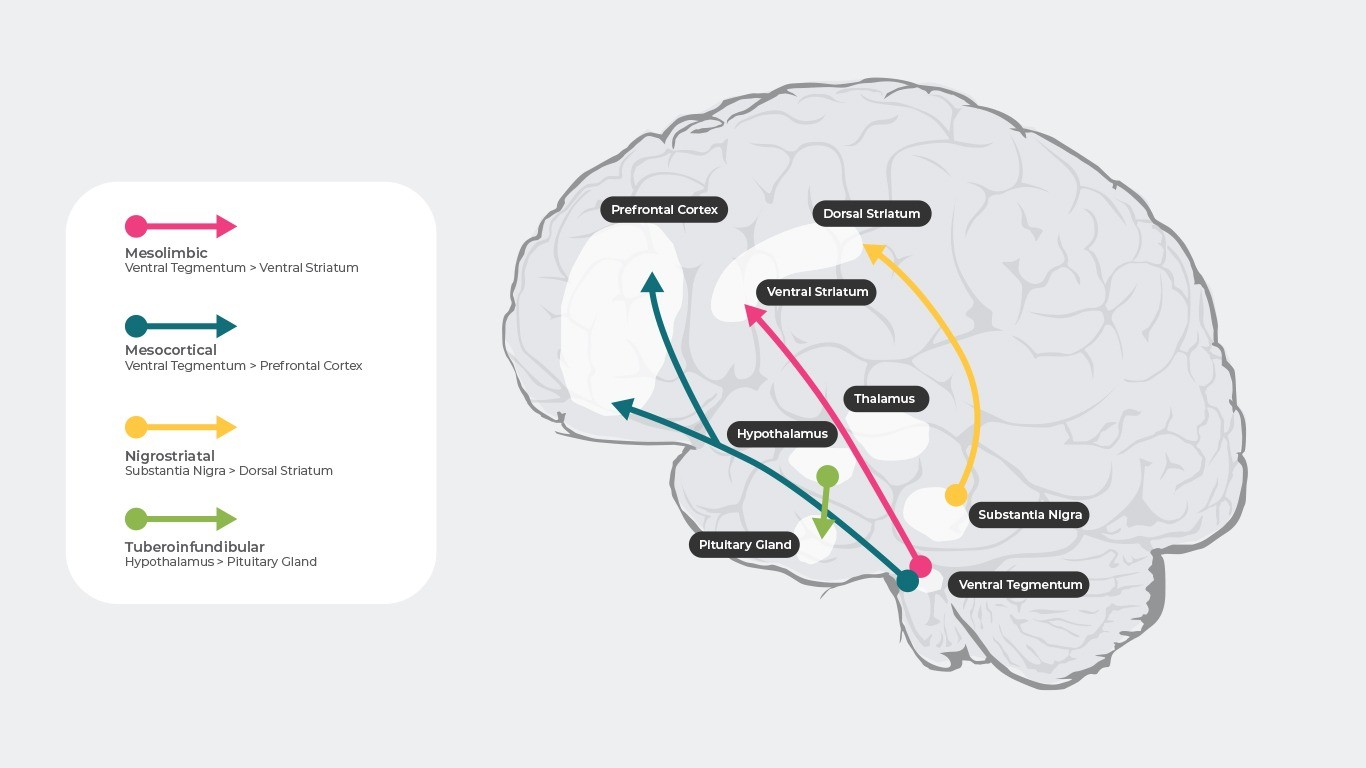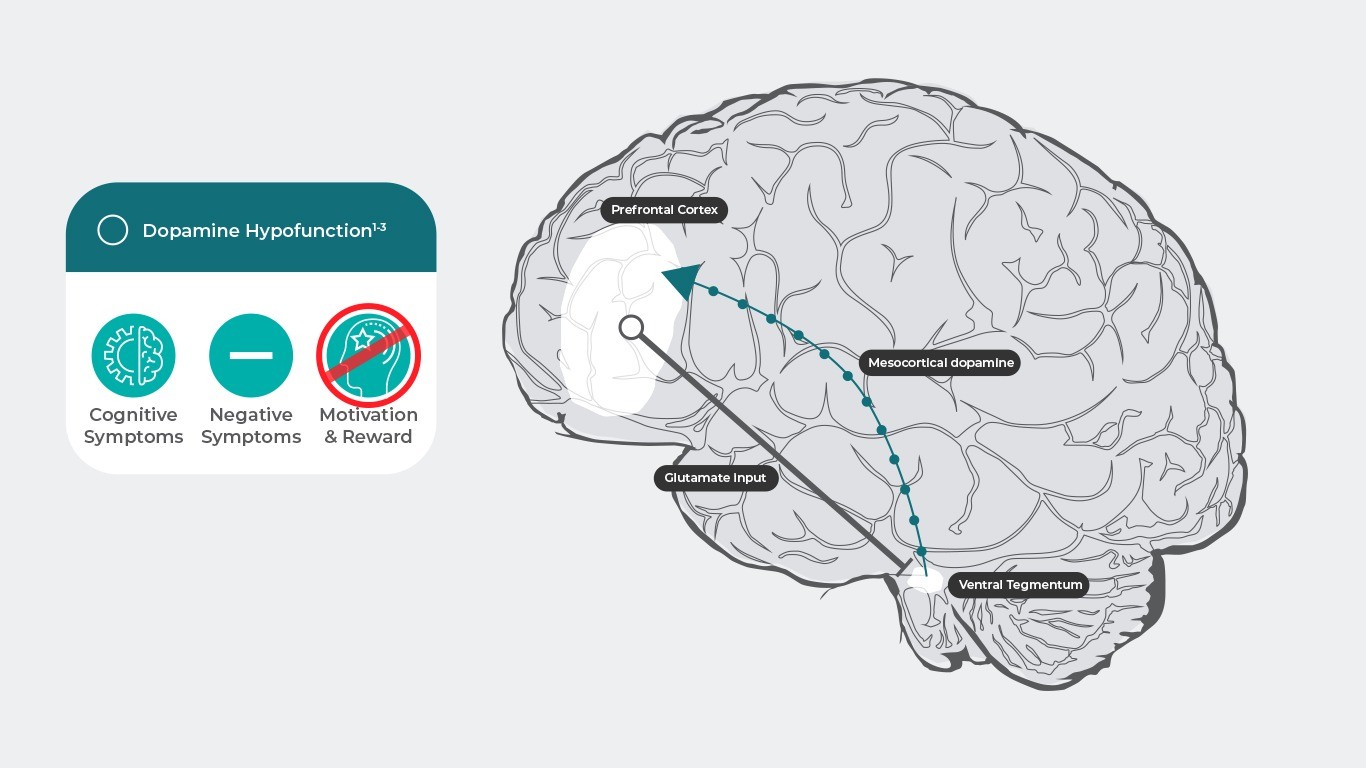Dopamine is a diverse and important neurotransmitter in the human body. Although it is typically thought of as our “reward and salience” neurotransmitter, it plays a role in controlling different functions including cognition, emotion, hormone regulation, voluntary motor movements, and positive reinforcement,… within its four major pathways.

1. Mesolimbic Dopamine Pathways
The first major dopamine pathway is the mesolimbic pathway. This pathway is highly involved in dopamine’s most commonly thought of function: pleasure and reward. This pathway begins at the ventral tegmental area (VTA). The VTA is a dopamine-rich nucleus that covers part of the midbrain and projects dopaminergic action potentials to another area of the brain called the nucleus accumbens (NAc). It is here in the NAc, where dopamine primarily mediates feelings of pleasure and reward.
Stimulation of the NAc is important for maintaining our day-to-day activity. However, over-stimulation can directly increase dopaminergic activity within the mesolimbic pathway, creating intense feelings of euphoria. So, it can lead to feelings of dependence and cravings.
In addition, the positive symptoms (hallucinations, delusions) of schizophrenia are thought to be due to the hyperactivity of dopamine in the mesolimbic pathway.

2. Mesocortical Dopamine Pathways
The second pathway is called the mesocortical pathway. Like in the mesolimbic pathway, dopaminergic projections within the mesocortical pathway originate in the VTA. From the VTA, action potentials travel to areas in the prefrontal cortex (PFC). The PFC is highly involved in cognition, working memory, and decision-making. Thus, when dysfunction within this pathway occurs, individuals may experience poor concentration and the inability to make decisions.
Taking certain medications, such as amphetamines, can upregulate the release of dopamine in the mesocortical pathway, which in turn increases cognition and activity in the PFC. Although this increase in dopamine within the mesocortical pathway may aid in cognition, it may have unintended side effects in the mesolimbic pathway. Conversely, too-low levels of dopamine in this pathway produce profound changes in cognition. In fact, it is thought that the negative symptoms of schizophrenia are largely explained by a hypoactivity of dopamine in the mesocortical pathway.

3. Nigrostriatal Dopamine Pathways
The next dopamine pathway is the nigrostriatal pathway, which is involved in motor planning. As the name implies, the dopamine projections start in the substantia nigra and go to the caudate and putamen, parts of the basal ganglia. This pathway contains around 80% of dopamine in the brain.
Dopaminergic neurons in the nigrostriatal pathway stimulate purposeful movement. Reduced numbers of dopamine neurons in this pathway are a major aspect of motor control impairment. Additionally, D2 antagonists, such as first-generation antipsychotics, interfere with the nigrostriatal pathway and can cause extrapyramidal symptoms including movement disorders such as spasms, contractions, tremors, motor restlessness, parkinsonism, and tardive dyskinesia (irregular/jerky movements).
4. Tuberoinfundibular Dopamine Pathways
The final dopamine pathway is the tuberoinfundibular pathway. The dopamine neurons in this pathway begin in the arcuate and periventricular nuclei of the hypothalamus, and project to the infundibular region of the hypothalamus, specifically the median eminence. In this pathway, dopamine is released into the portal circulation that connects this region to the pituitary gland. Here, dopamine functions to inhibit prolactin release.
Prolactin is a protein secreted by the pituitary gland that enables milk production and has important functions in metabolism and the immune system. Blockage of the D2 receptors, common with antipsychotic medications, prevents dopamine’s inhibitory function, thus increasing prolactin levels in the blood. Increases in prolactin can affect menstrual cycles, libido, fertility, bone health, or galactorrhea.
Source:
1. https://sanescohealth.com/blog/dopamine-pathways/
2. https://schizophrenialife.se/what-is-schizophrenia-quick-overview/